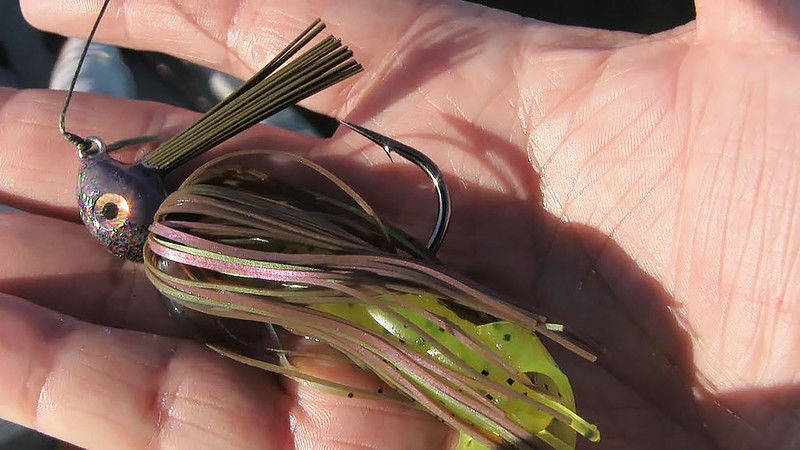Big jigs can be used to find big bass in any condition
Published 7:35 pm Saturday, April 22, 2017

- STEVE KNIGHT/TexasAllOutdoors.com FORMER B.A.S.S. FISHERMAN Terry Oldham believes fishing with a heavy jig is the best way to catch big bass. He says if a fisherman can fish a worm they can fish a jig.
STEVE KNIGHT
steve@texasalloutdoors.com
Trending
Ask Terry Oldham what are his five favorite bass lures and his answer is likely to be jig, jig, jig, jig and jig, in no particular order.
Oldham owns other lures, but unless it is jigs he is reluctant to throw them with the exception of an occasional spinner. And that is only until he gets the fish located and then he will probably throw a jig again.
“There is so much you can do with a jig day in and day out, and the size of a fish you can catch on a jig is generally bigger than you can catch on plastic. Not all of the time of course, but most of the time your jig fish are you bigger fish. Fishing tournaments and stuff that is what you are fishing the big ones for. The little ones don’t do you much good,” said Oldham who grew up jig fishing, fished them as pro on the B.A.S.S. tour from 1983-1995 and has been selling jigs through his Oldham Jigs out of Wimberley for decades.
Even without the vested interest of a manufacturer, Oldham believes the jig is the best bait year around to catch big fish. And not just any jig. To Oldham a three-quarter ounce jig is a lightweight.
“I make them for a living and not a jig in that bag is under three-quarters of an ouce. They are all one-ounce,” said Oldham recently while fishing Lake Comedero on a day he landed a 9-pound bass on a jig. “I won’t fish anything under three-quarter ounce and I fish them all the way up to an ounce and a half for punching the grass,” he said.
Trending
Oldham said fishermen often think a big jig is more likely to get hung up than soft plastics, but he finds he hangs up less with the magnum jigs than he will plastics.
Oldham said about the only time he will fish the lighter weight is when the water is cold and he’s trying to slow the bait down for the lethargic fish. Otherwise, he goes against the grain using heavier weights when the water is warm.
“Most of the articles written through the years tell you to fish as light a jig as possible, to kind of fish the cover you are fishing. That pretty much holds true if the water temperature is cool or cold, but it is just the opposite if the weather is hot. If you tell someone to fish a spinner bait fast or a Rat-L-Trap fast or a crankbait fast everyone understands that. They just pick up the tempo. When you are jig fishing the only way you can fish that jig fast is to pick up a bigger jig,” Oldham explained.
He said the magic number for water temperature is 80 degrees and up. Oldham said that is when he goes to the heaviest weight, not just to get through the vegetation, but because it is going to fall faster.
“And the fish want it going fast anyway. So it is not so much to punch the cover as it is the speed of the bait,” he said.
Oldham also will fish it in a technique that keeps it moving fast.
“A lot of times we hop the jig real hard off the bottom almost like fishing a jigging spoon. You hop it as hard as you can off the bottom and a lot of time that will trigger a strike. You don’t want to do that in cold water, but when the water gets 80-plus you can up the size of that jig and let the jig do most of the work for you. That is the only way you can increase that rate of fall is to up that size,” Oldham said.
The fisherman said the versatility of the jig is that it can be used to get through thick surface cover like hydrilla, can be used to work into submerged brush, skipped across rocks or dragged across a clean bottom. He has used it from Toledo Bend, Sam Rayburn and Conroe in East Texas to Falcon and Amistad to the west.
“I fish it everywhere. We fish power plant lakes, Falcon, Amistad, hydrilla. To me there has never been a better bait in the hydrilla. If there was one I would be fishing it. I have been fishing it a long time. A lot of guys throw plastic baits and that will work, but at the end of the day if a guy catches 20 fish and I catch 20 fish my 20 are going to be bigger on a jig most of the time,” Oldham said.
Like any bait the key to a jig is keeping it where the fish are located, in cover.
“That is the name of the game. That is where most of the fish are going to be,” Oldham said.
Despite the mystique of a jig being difficult to fish Oldham said it is really as easy as fishing a worm, with some caveats like needing to fish it vertical in really thick brush, and using longer casts to work more water.
“There is really nothing any simpler to me. A lot of people try to make it hard, but it is a piece of lead, it is going to go to the bottom. If you get it to the right area and put a little action on it they are going to nail it. They are not used to something like that dropping down in their living room,” he said.
While he typically uses a hard hopping motion called stroking to work the jig, Oldham said there are situations where dragging it across the bottom or an easier bounce could work. He also prefers the regular jig over the football head even though he makes both.
“Sometimes you have to let the fish tell you how they want it,” he said.
The fisherman also always uses a trailer to increase vibration as the bait drops and uses fluorocarbon to get the fastest drop.
If there is one thing fishermen need to learn to do to fish a jig vertically it would be to either pitch or flip. Oldham prefers to pitch and has taught himself holding the rod in his left hand because he was losing too many fish on the drop while switching hands. He believes it is something fishermen can teach themselves in the garage or front yard, or by going to the lake and doing nothing but flipping.
Oldham said that by going to the lake with nothing but jigs is how he taught himself to fish them initially.
“It is like learning to ride a bicycle. I cannot tell you how to ride a bicycle, but you have to get on that bike and skin up your own knees and elbows and then one day you wake up and you are riding your bicycle. Jig fishing is really the same ways,” Oldham said.






